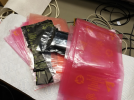Still similar, there are three main types of bag; the metalised one which is a shielding bag, the black one which is similar and the pink ones which are supposedly less likely to generate a charge but they aren't shielding bags. Yes, the bag is supposed to remain around the PCBA to keep it as a Faraday Cage.
I just happen to have a small selection of those at hand in my still currently untidy place (a plain bag got in there). Got some of the big mainboard size ones too

.

EEVblog has a couple of videos on it.
In the department in which I work we don't follow many static precautions apart from some basic grounding before handling boards which might be prototypes or, occasionally customer returns which will never go back into service and are for failure analysis. I tend to observe a bit more than others with benchmats and grounding plugs etc but I also have that level of ESD management in my home workshop

. I found a company for relatively cheap mats, the good ones like Norastat (I think) branded ones and I do need to upgrade a bit but haven't bought yet.
Speaking of mats, I did politely refuse a cubicle cleaning at work because, apart from them usually making more of a mess than I left, mats are supposed to be cleaned with specific stuff like Rezstore (Vermason looks like it might have merged or gone out of business as I used to use their sprays). Mine are that clean that Doris slapping a filthy rag onto them isn't really going to help.
We don't use ankle ESD straps as we don't have an ESD compliant floor although other departments in the building have those floors I'm not sure whether they have compliant footwear. I'm probaly the only one that could lay my hands on a wrist strap in under 10s.
Lab coats with conductive silver threads were a big thing when production existed in our place but they are probably only used during certain testing in the certification lab now. I didn't even get one when I started and by standard everyone had three, including one for having pictures taken! I had to scrounge mine out of the bin, then have an incorrect name badge...
The samples which we receive from our overseas production daughter-company (which is very, very modern) ship PCBAs in pink bags and black foam lined cardboard cartons with black (conductive) cardboard spacers. I recycle some of the foam in component cabinets as it isn't cheap stuff I also keep a bag or two out of the bin now and again.
It's difficult to say whether latent faults are being introduced to our boards in our department as they don't go into products, just used for development testing. There was talk that less compliant handling of the PCBAs might even highlight static damage failure mechanisms. I'm sure they have better ESD control in the production factory

. I've done a lot of testing on returned older products for faulty memory and whatnot but it's not easy to say for definite what caused it.
I have heard of, but not seen, people destroying prototype boards and development kits in our design office. Not surprising as when the atmospheric conditions are right the static is unreal. One year (might have been freezing and low moisture) I was walking about with a wrist strap on so I could discharge without getting painfully zapped.
Yes, I like my ESD compliance. Even if it's not totally required it looks good for when the top brass come visiting

. I also find the mats better to work on and they stop stuff skating around on the bench. Tools are usually fine if they are all metal, soldering irons might need tip grounding but a lot are already like that.
You can go as far as you want with ESD prevention. Benches, mats, ionisers, tools, paper files, pens, desk tidies...

